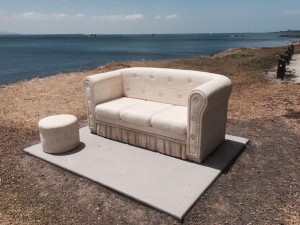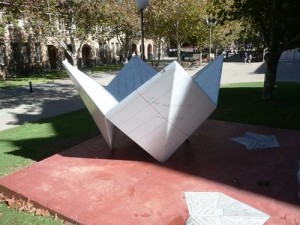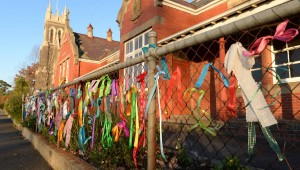A memorial dedicated to children who were in institutional ‘care’ has recently been installed on the Geelong foreshore in Victoria. The hand-carved limestone couch (by local artist Jacinta Leitch) was officially launched in July 2015.

Councillor Tony Ansett, who was instrumental in this memorial coming to fruition said: ‘Our aim was to create a place for people to spend a few quiet moments to think about the past … The seat may become an unofficial meeting place, a place of reflection and connection for people who were placed in care in Geelong orphanages’.
The Browse by Location lists on the Find & Connect web resource indicate just how many institutions have existed in Geelong, dating back to the Geelong Orphan Asylum, established in 1854.
The Senate report of the Inquiry into Children in Institutional Care (the ‘Forgotten Australians’ report, 2004) included a recommendation that governments, churches and agencies fund the erection of ‘suitable memorials commemorating care leavers’. State governments have since unveiled memorials to those who spent their childhoods in institutions – this page on the Alliance for Forgotten Australians website has details about the monuments in Brisbane, Sydney, Adelaide, Melbourne and Perth. In Hobart, there is a Rose Walk in the Royal Tasmanian Botanical Gardens recognising those who were in institutions as children.

Image by Graeme Saunders.
Source: Monument Australia website.
The ‘Unfolding Lives’ sculpture in Perth, dedicated in December 2010, has the following inscription:
‘This memorial brings the “Forgotten Australians” out of the shadows and into the light. Their most enduring legacy will be that the people now and in the future will know their stories and build upon them a platform for better care.
There is a strong thread that links the way a child is raised with the person they become in adulthood. This memorial stands as a reminder of that thread to all who create policies that affect children.’
These memorials are about commemorating and rethinking the past, as well as inviting reflection so that the future may be transformed.
Recent hearings of the Royal Commission into Institutional Responses to Child Sexual Abuse have given rise to a different types of memorial – the ‘loud fences’ seen in Ballarat and the purple ribbons tied to the gates of Knox Grammar in New South Wales. These spontaneous memorials provide a way for members of the community to show their support for those who have suffered abuse and to confront the silence of the past.







Karen Wilson
August 1, 2015 9:07 amInvariably whenever I use the term ‘Care Leavers’ most people respond by saying: ‘What does it mean?’ They are confused until I describe the categories that come under the umbrella of Care leavers. They baulk at using the term and would much prefer to ‘Forgotten Australians’ as an alternative. But then what about the Child Migrants? When they came out from England, they were considered ‘British’. There’s the conundrum. Personally I would prefer a word that encompasses all categories. Unfortunately I can’t think of an appropriate word.
Frank Golding
August 2, 2015 12:20 pmFair comment Karen. By the way, not all the Child Migrants came our of Britain. There was a significant group from Malta. There is a very attractive memorial to these children in Valetta, the capital city.
Frank Golding
July 27, 2015 3:59 pmThanks for another very interesting article – one that provides a neat summary of the main memorials around Australia. It raises again the issue I’ve written about earlier: is the label ‘Forgotten Australians’ any longer appropriate? Isn’t there an inherent contradiction being played out with memorials for forgotten people?
Consider these quotes from the various plaques:
– “For there is nothing hidden, except that it should be made known, neither was anything made secret out that it should come to light.” (Queensland).
– “We remember the lonely, the frightened, the lost, the abused…” (NSW)
– “To those who succumbed to harsh punishments meted out by a severe system we remember you.” (Tasmania)
– “Here we remember those thousands of children who were separated from their families…” (Victoria)
– “This memorial brings the “Forgotten Australians” out of the shadows and into the light. Their most enduring legacy will be that the people now and in the future will know their stories and build upon them a platform for better care.”
– And, capping it off: “We are no longer forgotten.” (SA)
How long can we go on calling ourselves ‘Forgotten’? I need look no further than the plaques themselves for better descriptions . On the inscriptions I find words like ‘lonely’, ”neglected’, ‘frightened’ or ‘abused’; while for more positive attributes I find words like ‘determination’, ‘courage’, ‘strength’, and ‘resilience’. Is it time for a re-think?
Cate O'Neill
July 28, 2015 9:47 amThank you, Frank, for this contribution to the continuing and always-evolving discussion about terminology and language.
(For those who are interested, here’s a link to another blog post by Frank on this topic: http://frankgolding.com/please-dont-call-me-a-forgotten-australian/).
In recent times, working on the Find & Connect web resource, and writing and speaking about the history of children’s institutions in Australia, my approach has been to try and use both terms (‘Care Leavers’ and ‘Forgotten Australians’) interchangeably. Sometimes, it’s possible to be mindful of your audience, and to use whatever term is preferred by particular individuals or groups. I also try not to rely on these terms and assume that everyone knows what they mean – sometimes it’s better to express it differently, ie ‘people who lived in institutions as children’.
It can be difficult – which is not to say that we should stop the conversation about terminology and language. I wonder if any of our readers would like to offer an opinion supporting the use of the term ‘Forgotten Australian’?